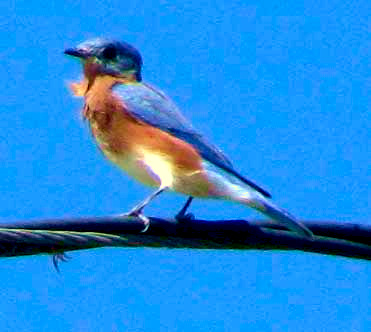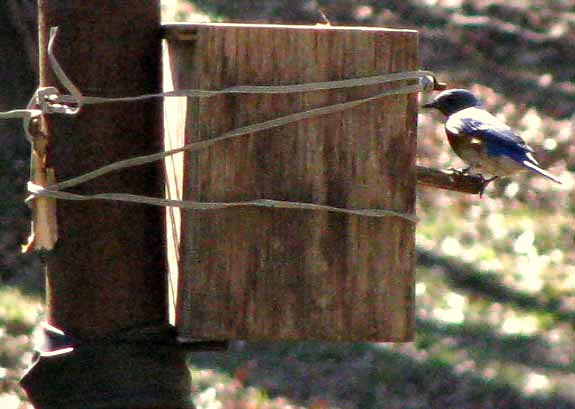Excerpts from Jim Conrad's
Naturalist Newsletter
from the October 7, 2012 Newsletter issued from the valley of the Dry Frio River in northern Uvalde County, southwestern Texas, on the southern border of the Edwards Plateau; elevation ~1750m (~5750 ft); N29.62°, W99.86°; USA
BLUEBIRDS IN SOUTHWESTERN TEXAS

Since my arrival here in August several times I've seen bluebirds flying around but with my poor vision and foggy binoculars I've been unable to figure out which bluebird species it was. According to the distribution maps, here in southwestern Texas both the Eastern and Western Bluebirds birds might possibly be permanent residents, or else occur only during the winter. Also we're pretty close to where Mountain Bluebirds overwinter, so even they can't be discounted. One afternoon this week when it was so breezy that a certain bluebird could hardly balance himself on a light wire and his chest feathers ruffled violently in the wind, I got his picture. Now I'm sure that we have at least his species here. That's him above.
That's a male Eastern Bluebird. He's just about as far west as you'll see the species during the winter. Unlike him, Western Bluebirds display rusty upper backs and blue throats, and Mountain Bluebirds lack our bird's rustiness altogether.
I'm told that bluebirds are seldom seen around here, but this week along the road passing by the cabin there's been a nice flock of them alternately riding the wind-whipped lines and swooping down onto the cow pasture below them to feed. They make very congenial and welcome neighbors.
from the March 9, 2009 Newsletter, issued from the forest near Natchez, Mississippi; elevation ~400ft (120m), ~N31.47°, ~W91.29°:
BLUEBIRD NEST BOXES
A couple of weeks ago several Eastern Bluebirds, SIALIA SIALIS, began hanging around the abandoned orchard's open area. We put up a nest box and in less than an hour a pair came to check it out. You can see the male peering intensely through the hole below:

That first day the birds put on a real show. The male would perch atop the box, fly onto the ground just below, then fly back as if visualizing himself doing that later when there's a brood to feed. The female entered the box and returned to the perch several times, giving the same impression. Most of the day they couldn't seem to get enough of entering and leaving the box.
The next day we put up two more boxes and before long they also had visitors. I think we have at least three pairs out there, maybe more.
Since that first day the birds haven't come around much, but at least once every day they do visit. Thinking anthropomorphically it seems that they've decided they like the nest boxes, but until they actually begin nesting they don't want to draw attention to them with their visits. However, at least once a day they can't resist a quick visit just to sure that everything still is there.
from the February 29, 2004 Newsletter, issued from near Natchez, Mississippi:
BUILDING A BLUEBIRD NESTING BOX
As during most of February, it's been an unusually rainy, chilly week here. It was a good time to build a bird box. The box I built was one designed with bluebirds in mind. Naturally I've set up a "How to Build a Nest Box for Bluebirds" on the Internet, providing the design I used, a picture of the final product being held by neighbor Karen Wise, and a nice picture of an Eastern Bluebird itself, at www.backyardnature.net/101/birdbox.htm.
One good thing about that design is that all you need is a board six inches wide and five feet long, and basic carpenter tools. It took me about an hour to build the whole thing. Constructing a box like this would be fun to do with a kid. The North American Bluebird Society provides several other nest box plans at www.nabluebirdsociety.org/plans.htm.
By the way, yesterday I heard my first Purple Martin of the season, a bit later than usual, probably because of the rains and because I'm farther from the river than in previous years.
from the March 28, 2004 Newsletter, issued from near Natchez, Mississippi:
BLUEBIRDS ON MY BLUEBIRD BOX
In this year's February 29th Newsletter I told you about my building a bluebird box, the design of which I posted on our website.
The day I nailed that box onto its pole down at the Field Pond, a certain unnerving thought came to mind. That is, of the approximately 392 bird species recorded as occurring in Mississippi, how can I presume that just one of those species, the Eastern Bluebird, will choose this nest box?
Therefore this week when one dusk I went to sit beside the Field Pond I was astonished to see a male Eastern Bluebird atop my creation, singing his heart out. He'd fly to the hole and disappear into the box's darkness, then reappear with his face framed by my jaggedly cut hole, then fly back to the top and sing some more, then return into the box, and he did this again and again, as if trying to convince himself that the box really worked. This inspired me to build a second nest box. Within two days it also had a male atop it behaving in the same manner.
At www.backyardnature.net/birdnest.htm, my bird-nest page, I mention six types of bird nest: scrapes; platform nests; cup nests; adherent nests; pensile nests; and, pendulous nests. My nest box was built for birds using cup nests, so that eliminated many species. However, cup nests are the most commonly encountered nest type, built by a host of other species besides bluebirds.
The mystery of how my box was finally chosen by a bluebird and not another species lies in the fact that each living thing lives its life occupying a narrow ecological niche. In the big tree outside my window Black-and-white Warblers glean the tree's bark, Red- eyed Vireos keep to the higher branches, and Carolina Chickadees prefer the lower branches. Nature is highly ordered, and invisible and inviolable boundary lines crisscross everything we see, or think we see.
I suspect that a chickadee or wren would have loved living in my nest box, but I placed it too far from the forest, too much in open air, for them. That box needed a bird loving open fields, but one thinking in terms of hollow snags or tree trunks for a nest site, and it needed a bird able to fit through the 1.5-inch hole I carved in its front. Of the 392 Mississippi bird species I know of, only the Eastern Bluebird fits all those criteria. My banged-together nest box is practically a job description for the Eastern Bluebird.
A neighbor built a nest box just like mine, and bluebirds came to check it out, but they rejected it. Probably that happened because, instead of placing the box near a large field, he put it near his house where he could see it. Bluebirds need plenty of field space to forage in, so if you don't have that, don't count on getting bluebirds.